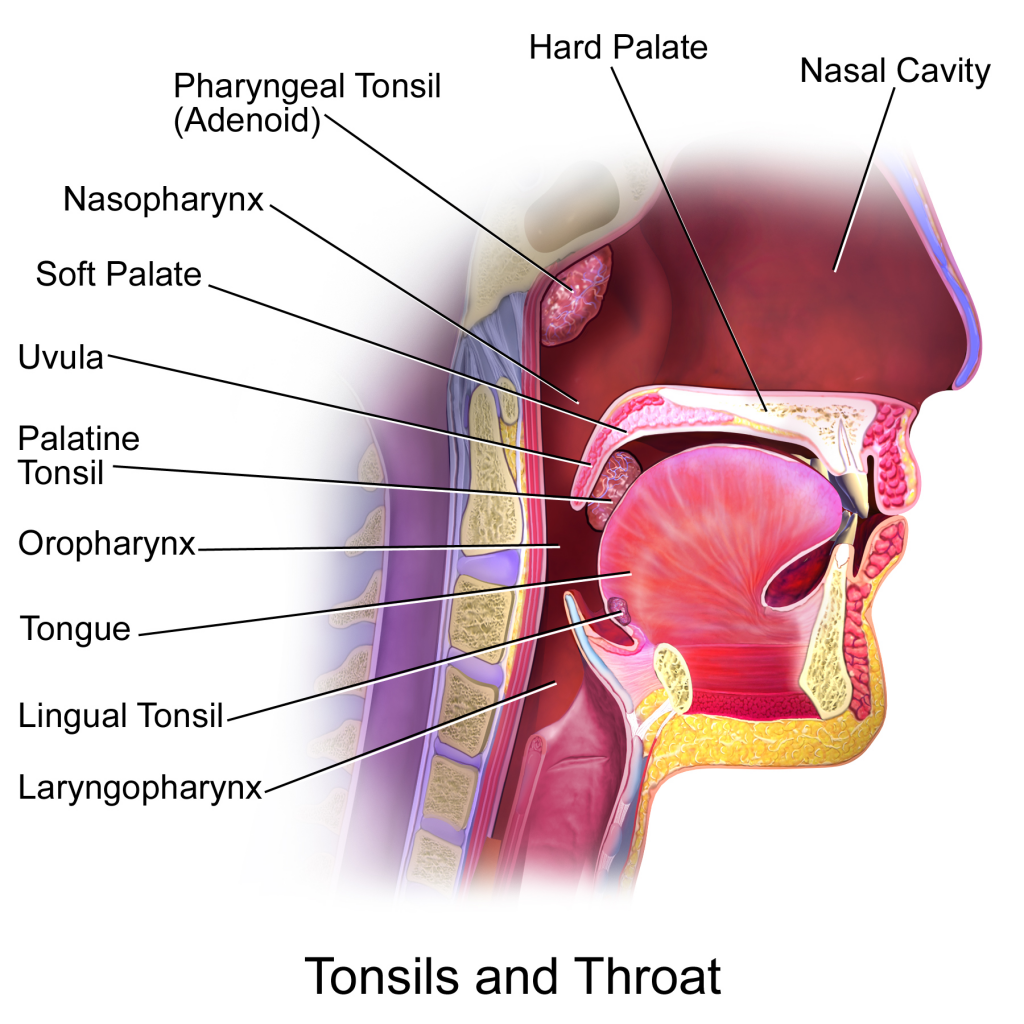
Anatomy
Head and Neck
Regarding the tonsils, which of the following statements is CORRECT:
Answer:
The lymphatic drainage of the palatine tonsils drains through the pharyngeal wall into the jugulodigastric nodes in the region where the facial vein drains into the internal jugular vein, inferior to the posterior belly of the digastric muscle.Tonsils
Anatomy / Head and Neck / Pharynx
Last Updated: 11th April 2019
Technically, there are three sets of tonsils in the body: the adenoid tonsil, the palatine tonsils, and the lingual tonsil.

Tonsils. (Image by Blausen.com staff. “Blausen gallery 2014”. Wikiversity Journal of Medicine. DOI:10.15347/wjm/2014.010. ISSN 20018762. (Own work) [CC BY 3.0 , via Wikimedia Commons)
Lingual Tonsil
The lingual tonsil is a large collection of lymphoid tissue found on the pharyngeal surface (posterior one-third) of the tongue.
Adenoid Tonsil
The adenoid (pharyngeal) tonsil is a large collection of lymphoid tissue in the mucosa covering the roof of the nasopharynx.
Palatine Tonsils
The palatine tonsils are on the lateral walls of the oropharynx. On each side there is a large ovoid collection of lymphoid tissue in the mucosa lining the superior constrictor muscle, between the palatoglossal and palatopharyngeal arches and just posterior to the oropharyngeal isthmus.
![Modified by FRCEM Success. Original by Henry Vandyke Carter [Public domain], via Wikimedia Commons](https://mrcemsuccess.com/wp-content/uploads/2017/01/Palatine-tonsil.png)
Palatine Tonsils. (Image modified by FRCEM Success. Original by Henry Vandyke Carter [Public domain], via Wikimedia Commons)
Blood Supply
The palatine tonsils are highly vascular, receiving blood from the ascending palatine and tonsillar branches of the facial artery, the descending palatine branch of the maxillary artery, a palatine branch of the ascending pharyngeal artery and a branch of the lingual artery.
Tonsillectomy may result in severe haemorrhage, which may occur from the branches of the facial, ascending pharyngeal, maxillary and lingual arteries, or from peritonsillar veins.
Lymphatic Drainage
The lymphatic drainage of the palatine tonsils drains through the pharyngeal wall into the jugulodigastric nodes in the region where the facial vein drains into the internal jugular vein, inferior to the posterior belly of the digastric muscle.
Report A Problem
Is there something wrong with this question? Let us know and we’ll fix it as soon as possible.
Loading Form...
- Biochemistry
- Blood Gases
- Haematology
| Biochemistry | Normal Value |
|---|---|
| Sodium | 135 – 145 mmol/l |
| Potassium | 3.0 – 4.5 mmol/l |
| Urea | 2.5 – 7.5 mmol/l |
| Glucose | 3.5 – 5.0 mmol/l |
| Creatinine | 35 – 135 μmol/l |
| Alanine Aminotransferase (ALT) | 5 – 35 U/l |
| Gamma-glutamyl Transferase (GGT) | < 65 U/l |
| Alkaline Phosphatase (ALP) | 30 – 135 U/l |
| Aspartate Aminotransferase (AST) | < 40 U/l |
| Total Protein | 60 – 80 g/l |
| Albumin | 35 – 50 g/l |
| Globulin | 2.4 – 3.5 g/dl |
| Amylase | < 70 U/l |
| Total Bilirubin | 3 – 17 μmol/l |
| Calcium | 2.1 – 2.5 mmol/l |
| Chloride | 95 – 105 mmol/l |
| Phosphate | 0.8 – 1.4 mmol/l |
| Haematology | Normal Value |
|---|---|
| Haemoglobin | 11.5 – 16.6 g/dl |
| White Blood Cells | 4.0 – 11.0 x 109/l |
| Platelets | 150 – 450 x 109/l |
| MCV | 80 – 96 fl |
| MCHC | 32 – 36 g/dl |
| Neutrophils | 2.0 – 7.5 x 109/l |
| Lymphocytes | 1.5 – 4.0 x 109/l |
| Monocytes | 0.3 – 1.0 x 109/l |
| Eosinophils | 0.1 – 0.5 x 109/l |
| Basophils | < 0.2 x 109/l |
| Reticulocytes | < 2% |
| Haematocrit | 0.35 – 0.49 |
| Red Cell Distribution Width | 11 – 15% |
| Blood Gases | Normal Value |
|---|---|
| pH | 7.35 – 7.45 |
| pO2 | 11 – 14 kPa |
| pCO2 | 4.5 – 6.0 kPa |
| Base Excess | -2 – +2 mmol/l |
| Bicarbonate | 24 – 30 mmol/l |
| Lactate | < 2 mmol/l |

